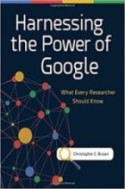 In his excellent guide Harnessing the Power of Google: What Every Researcher Should Know (Libraries Unlimited, 2017), author Christopher C. Brown asserts that:
In his excellent guide Harnessing the Power of Google: What Every Researcher Should Know (Libraries Unlimited, 2017), author Christopher C. Brown asserts that:
Librarians often hear from students that their instructor said not to use Google in their research. I believe that what is meant in most cases is that students shouldn’t only use resources that they just found with simple Google searches. Too many times students cite Wikipedia as an authority for their research. But what this book is arguing is that there is a proper place for Google in academic research.
Not only does the author argue his point successfully, he does every academic librarian and serious researcher the favor of showing them how to use Google so that it truly can become a credible component of rigorous scholarly and business research.
Brown is the Reference Technology Information Librarian for the University of Denver, a widely recognized expert in government information, and an affiliate faculty member in DU’s MLIS program, where his research courses are both wildly popular and dauntingly challenging.
The reason I mention his teaching role (I teach on an adjunct basis in the University of Denver MLIS program as well, so know the author as a colleague and friend) is that one of the terrific aspects of this book is how approachable and understandable it is. It’s reader-centric in the way a good teacher is student-centric, explaining basic if complex concepts through introductory overviews, familiar analogies, understandable examples, step-by-step case studies, and dozens of clarifying screen shots and comparative tables.
In terms of topic coverage, The Power of Google comprises 10 chapters that lead readers through the basics (how online and/or database searching works in general, how Google is structured and works, how to search using Google Web), then moves into more specialized knowledge areas.
These include “Power Searching for Primary Sources,” “Google Scholar and Scholarly Content,” “Google Books,” Google as a Complement to Library Tools,” “Academic Research Hacks,” and “Searching for Statistic.” A separate chapter is devoted to four step-by-step case studies in academic research that bring together the various strategies Brown has discussed throughout the book so readers can see strategy and tips become an effective implementation process.
Interwoven throughout are basic research concepts such as subject headings vs. subject descriptors; controlled vocabulary vs. full text searching; natural language searching; searching across metadata fields vs. full text; and the pros and cons of these various approaches to information structures. Brown does a great job of clarifying that one approach is not necessarily better than another, but rather that each approach has its strategic uses and drawbacks. His goal is not just to tell readers “here’s how this works,” but instead to clarify how to approach Google’s strengths and weaknesses to make the best use of the former and not be misled by the latter. For example, in one research approach he’s discussing, Brown points out that the searches being discussed “are often most valuable as a discovery tool, rather than a text-access tool.”
The book’ overarching question is “how do we think about information if it is not first categorized and normalized for us” through subject headings and similar guideposts. Brown’s goal is to provide an answer to that question by laying out a well-drawn roadmap that will enable students, researchers, teachers, professors, and librarians to confidently find, use, and cite authoritative primary and secondary sources using Google. As a business researcher, I find Brown’s book to be exceptionally helpful and confidence-building (even if my copy is by now a bit disfigured with multiple margin notes and highlights). It’s a must-have resource not only for academic librarians, but also for all serious researchers.
Brown, Christopher C. Harnessing the Power of Google: What Every Researcher Should Know. Libraries Unlimited, 2017. 134p. ISBN 978-1440857126.
